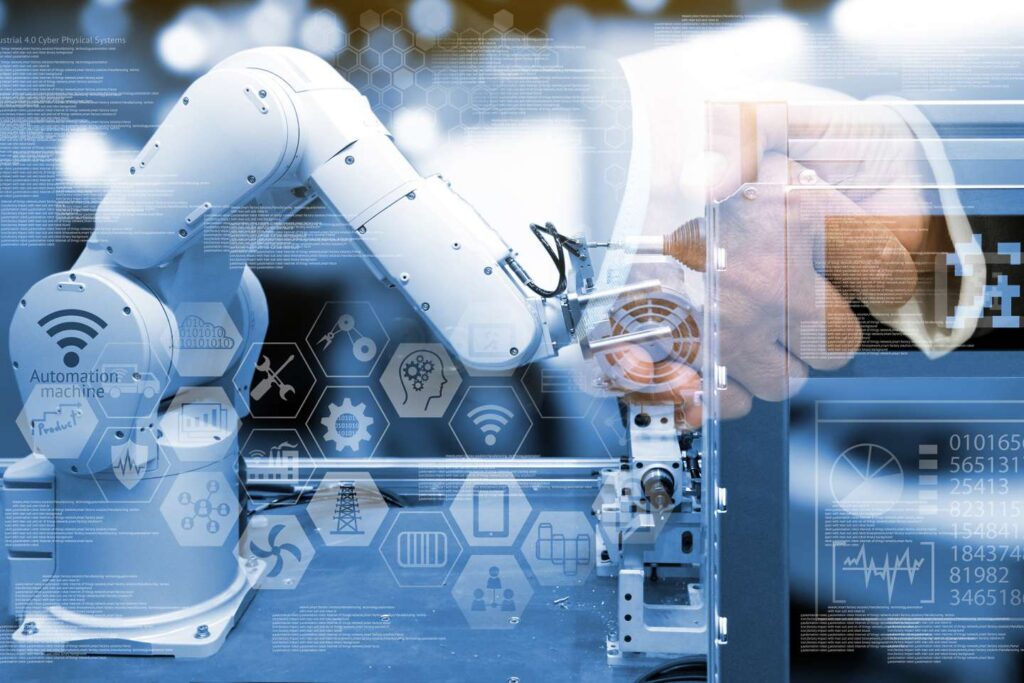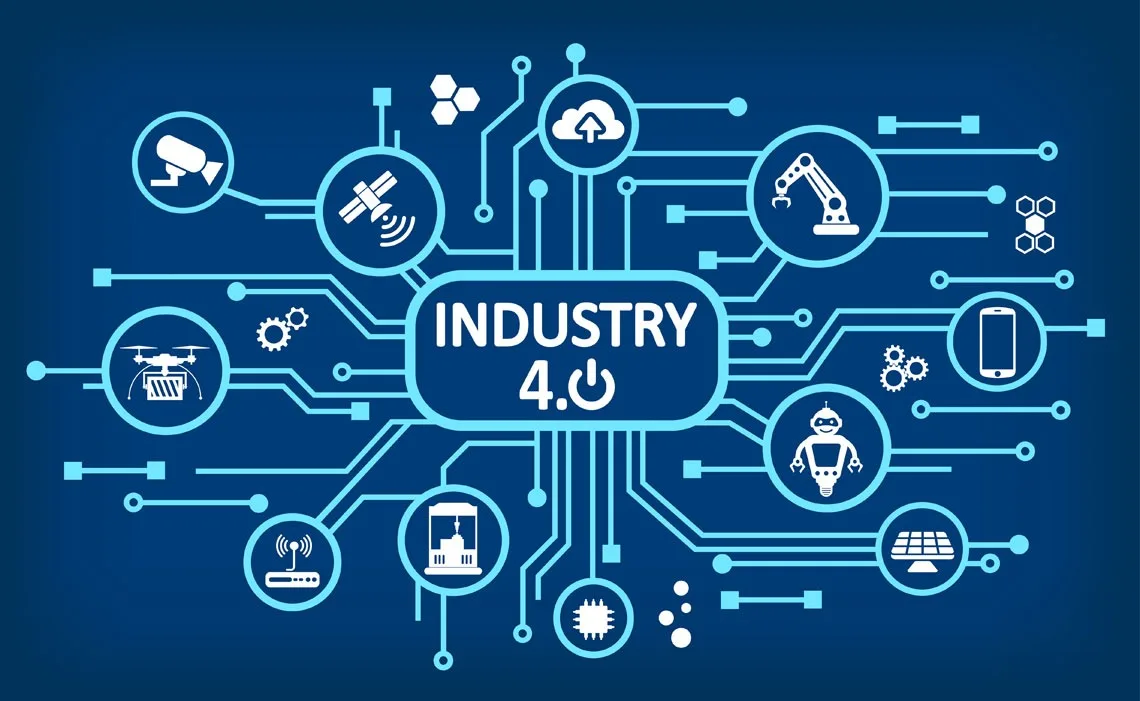Investment In Robotics And Automation: Transforming Industry 4.0
Industry 4.0 is an industrial revolution that defines digital transformation in almost every sector, bringing new investment in robotics and automation processes.
Compared to traditional methods, Industry 4.0 increases digitalization and automation in production and supply processes in almost every sector.
This digital revolution includes the Internet of Things (IoT), artificial intelligence tools, robotics, and automation solutions. Managing many operations in production processes with robotics and automation systems offers great commercial efficiency for businesses.
Thanks to investment in robotics and automation, production points or factories in many different sectors are undergoing Industry 4.0 transformation.
Many manufacturers and businesses in different areas, such as technology and health, are making investments, especially to transform their factories into “smart factories.”
Compared to traditional production methods, factories using robotics, automation, and artificial intelligence tools within the scope of Industry 4.0 require less manpower and resources. However, this transformation requires investment in robotics and automation in the adaptation process.
Why Is Investment In Robotics And Automation Crucial For Industry 4.0?

Industry 4.0 is an industrial revolution that proposes that manufacturers and supply processes in different sectors should be managed and maintained largely digitally.
The main reason why investment in robotics and automation is of critical importance for Industry 4.0 is that the transformation suggested by Industry 4.0 is largely provided by robotics and automation solutions.
In modern times, when digitalization is widespread in every sector, robotics and automation tools, especially in production lines, provide great efficiency for businesses.
Many manufacturers minimize production costs in all processes and operations from production to supply chain with investment in robotics and automation.
Thanks to robotics and automation solutions, potential human errors in production processes are eliminated, which provides a long-term standard for brands or businesses.
In recent years, many manufacturers from different sectors have been looking for ways to combine their traditional infrastructures with solutions such as robotics and automation to adapt to the Industry 4.0 digital revolution.
What Are The Key Benefits Of Investment In Robotics And Automation For Businesses?
Investment in robotics and automation has numerous advantages for both businesses and customers. While continuous access to a standard service and product is a great advantage for customers, it also offers numerous advantages for businesses.
The benefits of investment projects managed to develop robotics and automation processes for businesses can be listed as follows:
- It provides speed and standards in production processes.
- It reduces dependence on human power by minimizing labor costs.
- It minimizes error rates. Thanks to automation, every product is in the same form.
- Customer satisfaction increases.
In markets where competition is high, those who allocate resources to this transformation can get ahead. At first, it may not make sense for businesses to allocate resources to investment in robotics and automation.
However, in the medium and long term, there will be great efficiency and profitability due to the above advantages.
How To Identify Lucrative Opportunities In Investment In Robotics And Automation?
Today, there may not be incentive campaigns in every country and every sector in the field of investment in robotics and automation. However, businesses need to be interested in robotics and automation solutions to gain a competitive advantage in the long term.
First of all, they should research market trends and determine sectoral needs. Investment in robotics and automation projects can be developed for the required operation points.
If the local conditions where the businesses or factories are located are suitable and state incentive programs are offered, these can also be applied.
Because states benefit from investment in robotics and automation in the medium term. While the need for manpower in the production process decreases, commercial efficiency increases.
Instead of directly implementing solutions in the field of robotics and automation for businesses, it can also be profitable to invest financially.
Developments in this field indicate that the value of companies that offer such services will increase in the future. Providing financial support and becoming an investor to teams that manage startup projects in these areas today can provide significant profits in the future.
Products or services that can combine artificial intelligence solutions, especially in robotics and automation systems, will be very popular.
What Are The Top Trends In Investment In Robotics And Automation?
Within the Industry 4.0 transformation, many trends have emerged regarding investment in robotics and automation.
Robotic and automation solutions optimize production and supply processes very well. They provide both flexibility and increase commercial efficiency. So what are the trends in robotics and automation processes?
- Autonomous robots
- Artificial intelligence-supported systems and solutions
- Cobots
- IoT
- Cloud-based systems and data analytics
Autonomous robots are very critical solutions in the production processes of almost every sector. In the past, thousands of people worked on the production line in factories and not every product could be in the same form.
The conditions were not suitable for both the business and the employees. With the Industry 4.0 transformation, autonomous robots became widespread, and production processes became much faster and more comfortable.
Artificial intelligence-supported systems and tools are also one of the most common trends regarding investment in robotics and automation. Many factories or production points manage their production and supply processes through artificial intelligence-supported systems.
It is known that these innovative tools bring great efficiency, unlike traditional methods. Although cobots, IoT solutions, cloud-based systems, and data analytics tools are also common trends, the most widely used among them are artificial intelligence-supported solutions.
How Does Investment In Robotics And Automation Improve Operational Efficiency?

Thanks to investment in robotics and automation, businesses increase their operational efficiency in the medium and long term. One of the features that enable robotics and automation to increase efficiency in production processes is that it accelerates production processes.
Another benefit of this digital transformation is that it reduces error rates. While there may be a margin of error in some products produced with human power due to human error, thanks to investment in robotics and automation, every product has the same standard as each other in factories whose infrastructures are transformed with robotics and automation systems.
Today, many global brands manage almost all of their production and supply processes with robotics and automation solutions.
Startup projects are being developed in the fields of robotics and automation almost everywhere in the world. It is known that investments in this field increase operational efficiency in markets with high competition.
What Are The Challenges And Risks In Investment In Robotics And Automation?
Although investment in robotics and automation offers many advantages for both the companies that invest and other participants in the sector, I should remind you that there are also some risks and challenges.
Especially for businesses that want to combine their infrastructures with robotics and automation solutions for the first time, high initial costs are a significant challenge.
Many businesses have not yet completed their digital transformation due to high initial costs. Lack of technical knowledge is also a significant challenge.
Although investment in robotics and automation offers results that increase commercial profitability, the integration process may not be easy. Regardless of the scale of the business or factory, it is always difficult to adapt to new technology.
Changing existing and familiar methods can be difficult both in terms of cost and practicality. In addition, a technology and trend that is popular today can be completely forgotten after a short time. This rapid change can also be considered a challenge to remember for investment in robotics and automation.
How To Develop A Strategic Plan For Investment In Robotics And Automation?
Businesses need to have a strategic plan and roadmap during the investment in robotics and automation processes. They need to determine in which areas they need robotics and automation solutions. Every business should have a financial plan for this type of digital transformation.
In addition, training and infrastructure expenses should be taken into account. In addition, if it is remembered that short-term returns are not always possible, risk management should also be included in the strategic plan.
Depending on the sector you are a manufacturer in, you should determine at which points you need robotics and automation processes. It may not always be easy to replace traditional infrastructures with digitally intelligent production systems and robotic tools.
However, within today’s Industry 4.0 transformation, it may be useful to develop investment in robotics and automation projects at critical operation points, even if not completely.
Moreover, robotic and automation applications are seen not only in the production lines of the factories of the brands that sell products, but also in many different areas such as performing surgeries, providing transportation by optimizing metro networks automatically.
What Role Does AI Play In Investment In Robotics And Automation Technologies?
Artificial intelligence is one of the most popular robotics and automation trends of recent years. Businesses or investors from many different sectors allocate a large share to artificial intelligence tools in their investment in robotics and automation projects.
Thanks to artificial intelligence solutions, the operational efficiency of robots is gradually increasing for businesses. Artificial intelligence solutions offer some solutions for factories that produce, as in every sector.
Especially the use of artificial intelligence-supported technologies by the tools used in robotics and automation fields is increasing efficiency even more. The development of artificial intelligence technology also diversifies robotics and automation solutions.
Robotics and automation tools equipped with artificial intelligence systems analyze large amounts of data in a shorter time, allowing the most efficient production and supply chains to be managed in an automated manner.
Thanks to artificial intelligence tools, rapid progress is being made not only in supply chain management but also in the software field.
Among robotic and automation solutions, not only robots on the production line but also software that scans large amounts of data quickly and contributes efficiently to data analytics studies are some digital examples of robotics and automation.
Robotics and automation are the automatic management of all supply chain elements such as production, distribution, and logistics without the need for human intervention.
One of the reasons why robotics and automation are as advanced as they are today within the scope of the Industry 4.0 digital revolution is artificial intelligence solutions.
How To Measure ROI For Investment In Robotics And Automation?

One of the common metrics that investors in different investment areas use to measure the success of their projects is ROI. ROI stands for Return on Investment. With ROI, you can measure the profitability of an investment.
In order to measure the profitability of investment in robotics and automation projects, the ratio of your net profit to the costs of robotics and automation processes gives us the ROI result.
By looking at the ROI results, you can change the cost savings, production speed, and quality results of your investment in robotics and automation projects.
As in different investment models, it will be useful to set long-term financial targets for investment in robotics and automation. Adapting your factory’s production and supply chain processes with robotics and automation solutions today does not mean that you will achieve the results tomorrow.
In the highly competitive markets of the future, those who can provide this transformation will be able to remain strong in the very long term.
What Is The Future Of Investment In Robotics And Automation In Global Industries?
With every passing day, the share of investment in robotics and automation is increasing in the market. Many global brands allocate significant resources and energy to robotics and automation processes.
I can foresee that in the future, most of the daily operations such as open heart surgeries and optimizing the routes and times of airplanes will be managed by robotics and automation systems.
Even now, smart factories and work centers managed with completely autonomous systems have been established. In the future, many heavy workloads will probably be managed entirely with robotics and automation solutions.
Many factories from different sectors have started to switch to artificial intelligence-supported robotics and automation solutions. The number of investments in robotics and automation will increase not only in the field of technology but also in many other fields.
In the highly competitive markets of the future, robotics and automation solutions will be able to manage all the difficult processes from production to the supply chain in many global industries. It will be very useful to make investments in this field today and follow the innovations.
See you in the next post,
Anil UZUN
